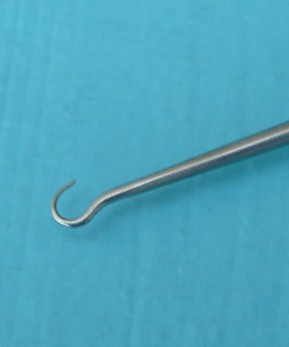Pathology of the skin is basically the same as those that occur in other organs. The changes that can be seen with the naked eye correlates well with that seen microscopically. The evolution of skin lesions can be readily followed by repeated biopsy.
The major functions of skin include sensory perception, protection against mechanical trauma, UV light and infection, insulation and temperature control, conservation of fluid, biosynthesis and excretion and aesthetic function. The morphology of the skin that appears simple at first sight is as complex and diverse as the 10 major functions of the skin - depending on the site, sex, age, race and environment.
Skin Biopsy: Select a site - not too early or too late but a fairly early representative lesion. Full thickness skin including the subcutaneous fat. The tissue is not to be grasped with forceps but a Gillies Hook (see below) to raise and maintain tension on the skin during removal.

Orientating the excised skin is important - it is helpful to press it gently - undersurface down on blotting papper before applying fixative (10% neutral buffered formal saline).
Reactive Changes in skin disease:
The skin has a limited range of responses to pathogenic agents and in many causes can result in similar responses. Inflammatory changes - eczematous reaction, erythema or granulomatous tissue response may be associated with many different aetiologies. Correlation of the histopathological features with the clinical history and naked eye appearances are extremely important to make a diagnosis.


No comments:
Post a Comment